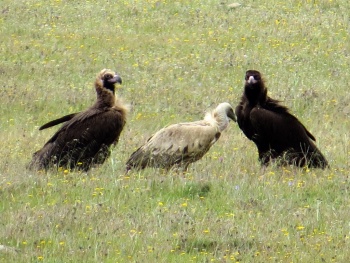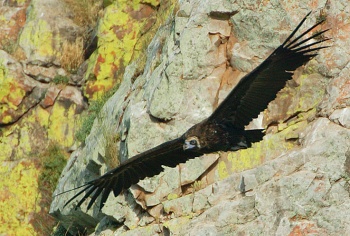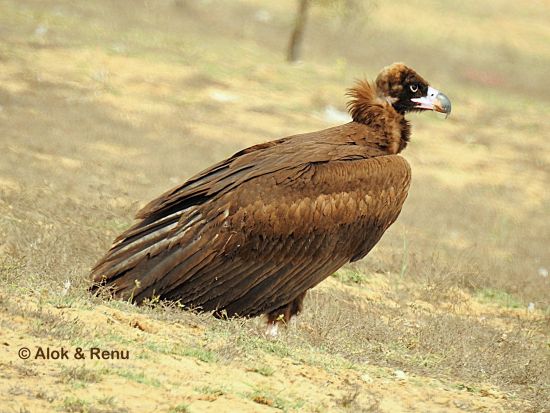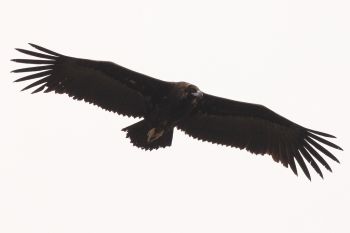Alternative names: Black Vulture1; Eurasian Black Vulture; Monk Vulture
- Aegypius monachus
Identification
Length 98–110 cm, wingspan 2.5–2.85 m, weight 7–12.5 kg
- Huge, with blackish-brown plumage
- Bald head
- Dark eye markings
- Blue-grey cere
- Bill massive, with pinkish base and dark horn-grey tip
- Grey legs and feet (visible at distance if catching the sun)
- In flight shows big, square wings and wedge-shaped tail
- Adult: tawny brown shoulder ruff contrasting with black throat and dark brown body feathering
- Immature: black shoulder ruff, no contrast with blackish body feathering

Photo © by Nutcracker
near Mertola, Baixo Alentejo, Portugal, April 2016
Distribution
Eurasia. Populations in the Western Palearctic are rare and declining in many areas, but in the west conservation action has resulted in increases in central Spain and Mallorca and reintroductions in northeast Spain and southern France. Elsewhere, rare in the east of Europe in northern Greece and southern Bulgaria; in Asia rare in Turkey and Armenia, the Crimea and the Caucasus, but more numerous in central Asia.
In 1996 began breeding in very small numbers in eastern Portugal after an absence of several decades and in the same year the first breeding in France for a century took place in the Massif Central as a result of a reintroduction programme. Occurs with some regularity in the Rhodope Mts of Bulgaria but breeding is rare. More numerous and widespread further east ranging from northern Iran east to northern and western China.

Photo © by Steve G
Salto del Gitano, Monfrague National Park, Extremadura, Spain, May 2004
Most are resident as adults, but young birds disperse, often to areas outside breeding range. Guadalquivir marismas are a regular haunt of immatures in Spain, especially in winter and there are often small numbers present in south Portugal. Mallorcan birds are rarely seen outside breeding range in the mountains of the north. Very small numbers recorded annually crossing the Bosphorus, and recorded south to Sinai and Egypt.
In the past also recorded in many European countries north to the Netherlands, Denmark and Estonia but today most records from northern Europe are thought more likely to be escapes. One recorded in Wales in the winter of 1977-78 is not accepted as a wild bird. However, birds thought to be genuine vagrants recorded in Tunisia in March 1991 and southern France in April 1991. More recently a juvenile in the Netherlands in July-August 2000 is accepted as a wild bird.
Vagrants also recorded in Switzerland, Cyprus and the Straits of Messina, Sicily. In the east a rare visitor to Burma and northern Indochina and a vagrant to Hong Kong and Japan.
Taxonomy
This is a monotypic species[1].
- Not to be confused with [American] Black Vulture Coragyps atratus.
Habitat
Found in hilly and mountainous country, sometimes lowlands, in wooded or open areas.
Behaviour
Diet
Searches for carrion over open areas with domestic stock or wild ungulates. The largest vulture in the Old World (South America's Andean Condor is slightly larger, and California Condor is about the same size), with a powerful bill capable of tearing through tough animal skins. Dominates over other vultures at carcasses.
Breeding
Nest is usually built in a tree, sometimes on a rock ledge. One egg laid (very rarely two); incubation lasts 2 months and the chick takes 3-4 months to fledge, and most of the rest of the year to reach full independence. Pairs often takes a year out between nesting attempts.
References
- Clements, JF. 2009. The Clements Checklist of Birds of the World. 6th ed., with updates to December 2009. Ithaca: Cornell Univ. Press. ISBN 978-0801445019.
- Wikipedia
Recommended Citation
- BirdForum Opus contributors. (2025) Cinereous Vulture. In: BirdForum, the forum for wild birds and birding. Retrieved 12 May 2025 from https://www.birdforum.net/opus/Cinereous_Vulture
External Links
GSearch checked for 2020 platform.1





